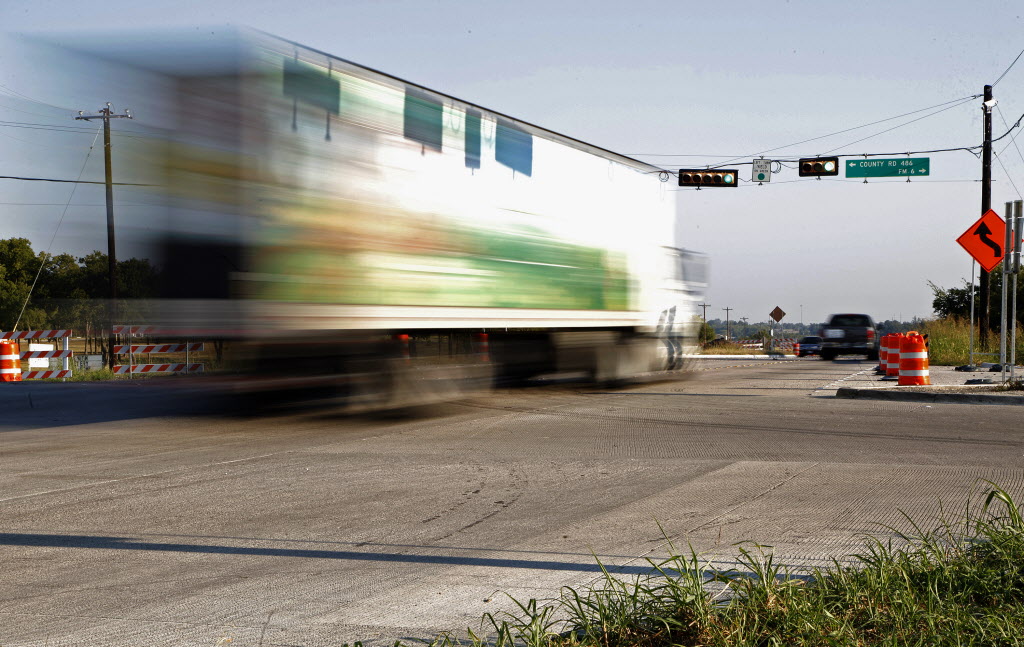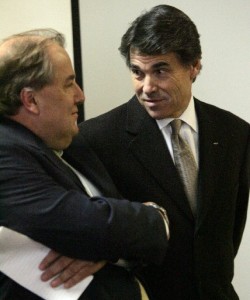
Traffic at the intersection of State Highway 78 and County Road 6 in Lavon, on the east side of Collin County in September 2014. Regional leaders say increased traffic at this and several other intersections show the need for a toll road from Garland to Greenville. (Stewart F. House / Special Contributor )
More than 30 people from across North Texas showed up in front of a Hunt County government building Tuesday to protest a planned rural toll road from Garland to Greenville.
“We’re all citizens not wanting this thing,” said Bryan Slaton, a Royse City resident who spoke in front of the crowd of residents.
Many opponents to Northeast Gateway held signs that said, “No eminent domain for private gain,” and “Hands off our land.”
Slaton and others this morning said it is “un-American” that Texas Turnpike Corp. has the rare ability as a private company to use eminent domain to take land for projects.
Slaton also accused the North Central Texas Council of Governments of inflating traffic projections to justify the need for the road. The Dallas Morning News last month reported about how NCTCOGs’ traffic estimates dramatically outpace state population growth projections.
NCTCOG transportation director Michael Morris last week told his organizations’ transportation council that he stands by the traffic projections, but did not give details. Members of the Regional Transportation Council did not ask for more details.
NCTCOG has already recommended adding the road to long-term regional transportation plans, but could reverse that recommendation this week in light of mounting opposition.
Regional Transportation Commission member and Carrollton Mayor Matthew Marchant said last month he plans to recommend stripping the road from the long-term planning document when it comes up for a vote in November. Marchant said the RTC should only recommend toll road construction as a last resort.
“I don’t know if we’re at that point on this corridor yet,” he said.
Slaton this morning said a state study shows Texans don’t want more toll roads. He also said both candidates in next month’s gubernatorial race oppose more toll roads in Texas.
“The one common ground they share is no toll roads,” he said.
The group then went inside a Hunt County Commissioners Court meeting to speak out against the project. Hunt County Judge John Horn, who presides over commissioner meetings, is a chief supporter of the project.
The project was not on the commissioners court agenda for its regular 10 a.m. meeting this morning. But Texas law allows residents to speak on matters that aren’t on an agenda during a public comment portion of government meetings. Speakers are generally required to fill out a card before the meeting begins so they can be recognized during the meeting.
Toll road opponents showed up outside the commissioners court meeting room a few minutes before the meeting was supposed to begin, but it was already under way. Commissioners had already moved pass the public comments portion of the meeting, the consent agenda and the first two individual action items.
As the meeting progressed, a bailiff handed Slaton and others speakers cards. After they turned them back in, the bailiff took them to Horn in the middle of the meeting.
Horn moved away from his microphone and conversed with the bailiff out of public earshot before calling a recess. Horn went outside the meeting room and asked Slaton if he was willing to serve as a spokesman for the entire group rather than allowing everyone to speak.
“We’ve got other business,” Horn told Slaton.
Slaton said he could not speak for everyone in the group.
“I’m trying to expedite this,” Horn said.
Before Horn returned to the courtroom, a reporter asked him whether the public comments portion section on the court’s agenda limits how many people can speak. The reporter also asked what time the meeting started.
Horn said it started at 10 a.m. When the reporter said the meeting was already in progress before 10 a.m., Horn said the commissioners go by the clock in the meeting room. The clock in that room was running about five minutes fast Tuesday morning.
After Horn returned to the meeting room, he told attendants that he had asked “for the purpose of time and business” if only one person was willing to speak to everyone, but said the court would hear from everyone who signed up.
“We want to extend to you our hand in courtesy,” he said.
Jerry Shaffer of Wylie said the road is a form of double taxation because Texans already pay for highways through gas taxes. Kevin Long of Caddo Mills criticized Texas Turnpikes’ ability to use eminent domain.
“It may be legal, but that doesn’t mean it’s right,” he said.
Brenda Short of Fate said she moved away from Dallas to be away from “all this concrete.” Short said she believes a new alignment of the road will no longer require the taking of her property. But she’s still opposed to the effects of the road.
“It’s going to change the landscape of Hunt County forever,” she said.
Tiffany Long said commissioners would have to listen to opponents at every meeting as long as they hold their seats.
“Because we will vote you out of office,” she said.











